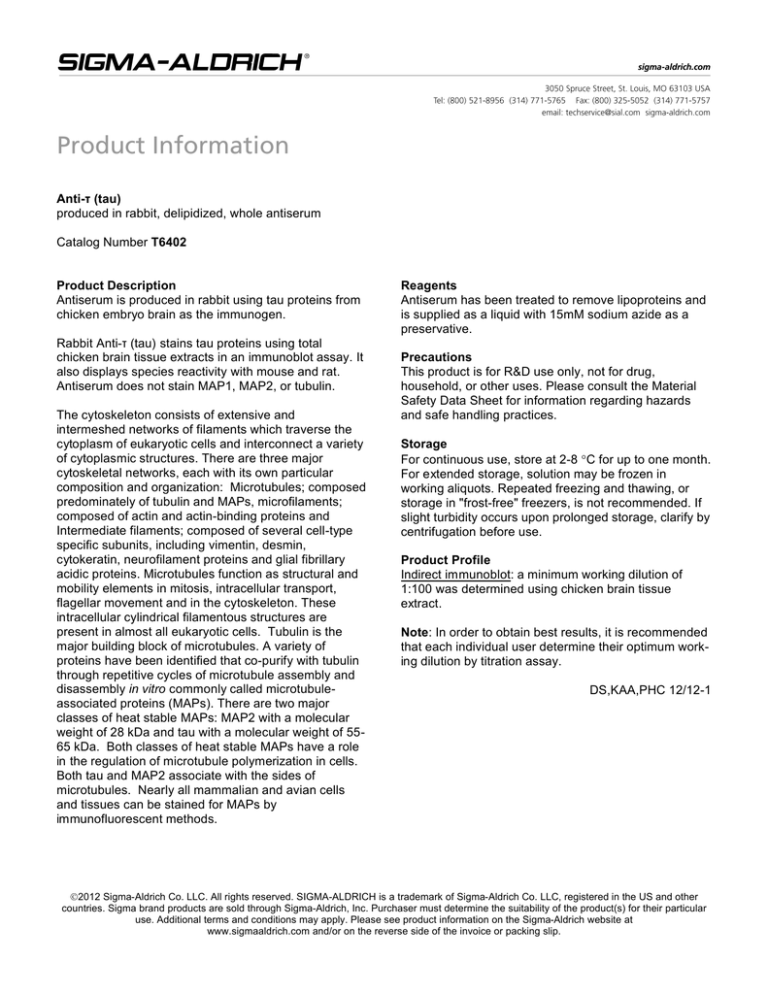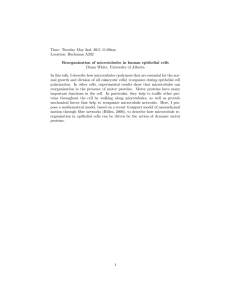
Anti-τ (tau)
produced in rabbit, delipidized, whole antiserum
Catalog Number T6402
Product Description
Antiserum is produced in rabbit using tau proteins from
chicken embryo brain as the immunogen.
Rabbit Anti-τ (tau) stains tau proteins using total
chicken brain tissue extracts in an immunoblot assay. It
also displays species reactivity with mouse and rat.
Antiserum does not stain MAP1, MAP2, or tubulin.
The cytoskeleton consists of extensive and
intermeshed networks of filaments which traverse the
cytoplasm of eukaryotic cells and interconnect a variety
of cytoplasmic structures. There are three major
cytoskeletal networks, each with its own particular
composition and organization: Microtubules; composed
predominately of tubulin and MAPs, microfilaments;
composed of actin and actin-binding proteins and
Intermediate filaments; composed of several cell-type
specific subunits, including vimentin, desmin,
cytokeratin, neurofilament proteins and glial fibrillary
acidic proteins. Microtubules function as structural and
mobility elements in mitosis, intracellular transport,
flagellar movement and in the cytoskeleton. These
intracellular cylindrical filamentous structures are
present in almost all eukaryotic cells. Tubulin is the
major building block of microtubules. A variety of
proteins have been identified that co-purify with tubulin
through repetitive cycles of microtubule assembly and
disassembly in vitro commonly called microtubuleassociated proteins (MAPs). There are two major
classes of heat stable MAPs: MAP2 with a molecular
weight of 28 kDa and tau with a molecular weight of 5565 kDa. Both classes of heat stable MAPs have a role
in the regulation of microtubule polymerization in cells.
Both tau and MAP2 associate with the sides of
microtubules. Nearly all mammalian and avian cells
and tissues can be stained for MAPs by
immunofluorescent methods.
Reagents
Antiserum has been treated to remove lipoproteins and
is supplied as a liquid with 15mM sodium azide as a
preservative.
Precautions
This product is for R&D use only, not for drug,
household, or other uses. Please consult the Material
Safety Data Sheet for information regarding hazards
and safe handling practices.
Storage
For continuous use, store at 2-8 °C for up to one month.
For extended storage, solution may be frozen in
working aliquots. Repeated freezing and thawing, or
storage in "frost-free" freezers, is not recommended. If
slight turbidity occurs upon prolonged storage, clarify by
centrifugation before use.
Product Profile
Indirect immunoblot: a minimum working dilution of
1:100 was determined using chicken brain tissue
extract.
Note: In order to obtain best results, it is recommended
that each individual user determine their optimum working dilution by titration assay.
DS,KAA,PHC 12/12-1
2012 Sigma-Aldrich Co. LLC. All rights reserved. SIGMA-ALDRICH is a trademark of Sigma-Aldrich Co. LLC, registered in the US and other
countries. Sigma brand products are sold through Sigma-Aldrich, Inc. Purchaser must determine the suitability of the product(s) for their particular
use. Additional terms and conditions may apply. Please see product information on the Sigma-Aldrich website at
www.sigmaaldrich.com and/or on the reverse side of the invoice or packing slip.


